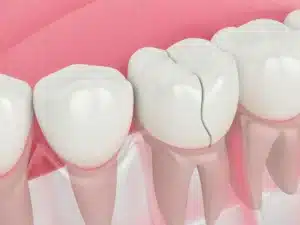
At Hekmat Dental Care, we understand the discomfort and inconvenience that come with cracked or chipped teeth. Our dedicated team, led by Dr. Hekmat, is committed to providing top-notch dental care tailored to your individual needs. Whether you’re experiencing unexplained pain while eating or sensitivity to hot and cold foods, our state-of-the-art facility in Rancho Bernardo and 4S Ranch is equipped to address all types of tooth cracks. With a focus on personalized treatment plans and cutting-edge technology, we ensure that you receive the highest quality care possible. Contact us today at 858-485-5925 to schedule your consultation and take the first step towards a healthier, happier smile.
Cracked, chipped, and fractured teeth are common dental problems. As people retain their natural teeth longer (due to advances in dental technology), the likelihood of cracked or chipped teeth increases. There are many reasons teeth may crack, such as biting on hard objects, trauma, grinding, and clenching of teeth. These behaviors put the teeth under extra strain and make them more susceptible to cracking.
When tooth enamel is cracked, pain can become momentarily debilitating. Without pressure on the crack, there may be no discomfort. However, as the cracked tooth performs a biting action, the crack widens. The pulp and inner workings of the tooth then become exposed, and painful irritation occurs. As pressure is released again, the two parts of the crack fuse back together, and pain subsides. If left untreated, the pulp becomes irreversibly damaged and constantly painful. The resulting pulp infection can affect the bone and soft tissue surrounding the tooth.
Symptoms of a cracked tooth may include:
- Unexplained pain when eating.
- Sensitivity to warm and cold foods.
- Pain with no obvious cause.
- Difficulty pinpointing the location of the pain.
Causes of Tooth Cracks:
Teeth may crack due to various factors, including biting on hard objects, trauma, and teeth grinding or clenching. These behaviors exert additional strain on teeth, making them more susceptible to cracking.
Types of Tooth Cracks:
Crazes – These are generally tiny vertical cracks that do not place the teeth in danger. These scratches on the surface of the teeth are considered by most dentists to be a normal part of the tooth anatomy. A craze rarely requires treatment for health reasons, but a wide variety of cosmetic treatments can be performed to reduce the negative aesthetic impact.
Oblique supragingival cracks – These cracks only affect the crown of the tooth and do not extend below the gum line. Usually, the affected part of the tooth will eventually break off. Little pain will result because the tooth pulp (that contains the nerves and vessels) will remain unaffected.
Oblique subgingival cracks – These cracks extend beyond the gum line and often beyond where the jawbone begins. When a piece breaks off, it will usually remain attached until the dentist removes it. Oblique subgingival cracks are painful and may require a combination of periodontal surgery (to expose the crown) and endodontic treatment to place a crown or other restorative device.
Vertical furcation cracks – These cracks occur when the roots of the tooth separate. This type of crack almost always affects the nerve of the tooth. Because the tooth will not generally separate completely, root canal therapy and a crown can usually save the tooth.
Oblique root cracks – These cracks tend not to affect the surface of the tooth at all. In fact, the damage is only apparent below the gum line and usually below the jawbone. Root canal therapy may be possible, depending on how close the fracture is to the tooth surface. However, extraction is almost always the only option after sustaining this classification of fracture.
Vertical apical root cracks – These cracks occur at the apex (tip of the root). Though the tooth does not require extraction from a dental perspective, many patients request an extraction because of the high degree of pain. Root canal therapy alleviates the discomfort for a while, but most often, teeth affected by such cracks are eventually extracted.
Treatment Options:
There are many different types of chipped or cracked teeth. Some can only be exposed using X-ray machines, while others are clearly visible to the naked eye. In cases where the tooth root is affected, root canal therapy is the most viable treatment option.
Root Canal Therapy:
- Removes pulp, nerves, and vessels.
- Fills the space with gutta-percha.
- Stabilizes the tooth with a crown or filling.
Extraction:
- When the crack is severe and the tooth cannot be saved.
- Restorative options include bridges, dental implants, and partial dentures.
Dr. Hekmat utilizes cutting-edge technology and personalized treatment plans to address cracked teeth effectively. If you have any concerns or questions about cracked teeth, please don’t hesitate to contact Hekmat Dental Care at (858) 485-5925. Your dentist in Rancho Bernardo is here to provide the expert care you deserve.
